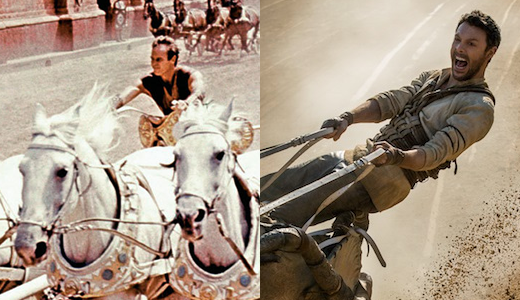The nearly four-hour epic Ben-Hur, released in 1959, won an unprecedented 11 Academy Awards including Best Picture and Best Actor for Charlton Heston. The American Film Institute lists it at No. 72 on their list of “America’s 100 Greatest Movies.”
If it’s that good, then why will Mark Burnett and Roma Downey release a new version later this summer?
When I screen the film in Los Angeles, I plan to ask them. My guess, though, is that Burnett and Downey are huge fans of the 1959 version (and possibly the original, silent, 1925 version too), but they realize that the number of viewers of Heston’s version has fallen to a virtual trickle. It’s probably safe to say that most people under 25 haven’t seen the film and have no plans to do so. But a new Ben-Hur (coming out on Aug. 19) is sure to garner attention and put the title back on the lips of millions of people, both here and abroad.
That’d be nice. Because the core story of Judah Ben-Hur is timeless.
Before the movies, there was the Lew Wallace book that launched it all. Titled Ben-Hur: The Tale of the Christ and published in 1880, this classic is considered by many as the most influential Christian book of the nineteenth century, not to mention a best-seller of that period. (We have a review of the book here.)
But Wallace didn’t start out to write a Christian novel. He actually penned a short story based on the biblical account of the wise men attending Jesus’ birth. And he penned it as an unbeliever. It wasn’t until he was challenged by an agnostic’s claims against the Bible, God and Christ, that Wallace starting searching for the truth himself. According to christianity.com:
His second novel, Ben-Hur, was conceived after sitting on a train, listening spellbound for two hours, while the agnostic Colonel Robert Ingersoll, poured out “a medley of argument, eloquence, wit, satire, audacity, irreverence, poetry, brilliant antitheses, and pungent excoriation of believers in God, Christ, and Heaven, the like of which I had never heard.”
Until then, Lew had been indifferent to the claims of religion (although he loved the story of the wise men and had begun a tale about them). “… Yet here was I now moved as never before, and by what? The most outright denials of all human knowledge of God, Christ, Heaven… Was the Colonel right? What had I on which to answer yes or no? He had made me ashamed of my ignorance: and then—here is the unexpected of the affair—as I walked on in the cool darkness, I was aroused for the first time in my life to the importance of religion. … I thought of the manuscript in my desk. Its closing scene was the child Christ in the cave by Bethlehem: why not go on with the story down to the crucifixion? That would make a book, and compel me to study everything of pertinency; after which, possibly, I would be possessed of opinions of real value.
It only remains to say that I did as resolved, with results—first, the book Ben-Hur, and second, a conviction amounting to absolute belief in God and the Divinity of Christ.
And this short news clip from CBN News two years ago gives even more background on Wallace:
Incidentally, if you’ve heard that a person actually died during the filming of the chariot race in the 1959 version (as I had), you’ll be happy to know it’s not true (according to Snopes). However, it was true about the filming of the 1925 version.
While the story of Ben-Hur revolves primarily around Wallace’s fictional character, Judah Ben-Hur, there’s no doubt that the main character was Jesus Christ Himself. Not a single word is spoken by Jesus here. And His screen time probably amounts to less than two percent of the film. But Christ’s impact on Judah, his mother and sister, is the heart of this story. A story that has touched millions in both book and film form. A story that is on the cusp of touching a new generation.






Recent Comments